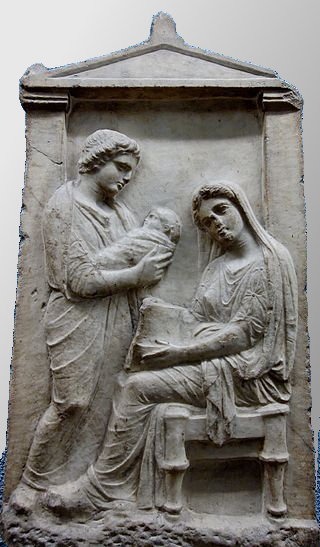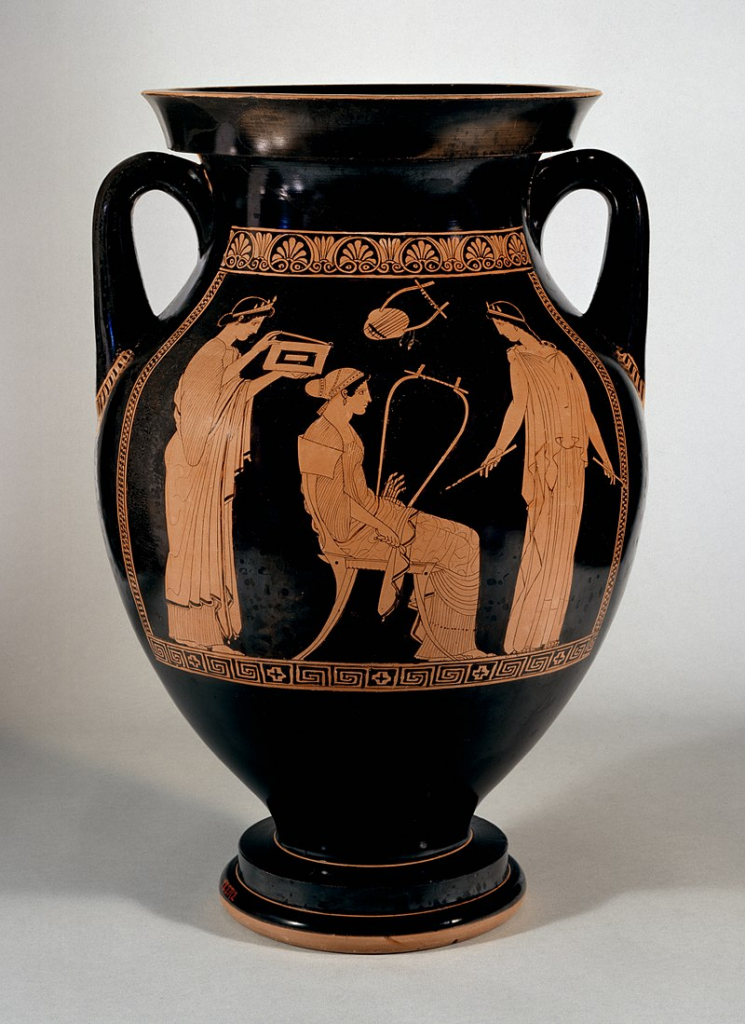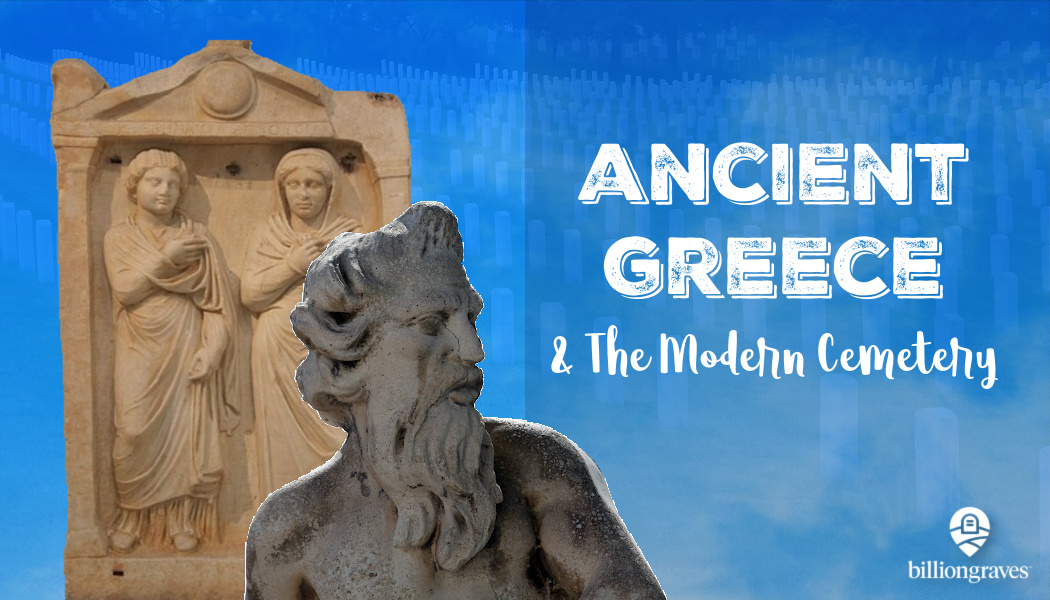Ancient Greece and the modern cemetery share many of the same symbols. From the flaming Olympic torch, to laurel wreaths, and classical columns, Greek influence can be seen in nearly every cemetery in the Western world.
Beginning about 800 BC, the wealthy elite created monuments to stand in their place after they died. These markers became increasingly larger and more elaborate as time passed. The grave markers had symbols on them that are remarkable familiar to those who visit cemeteries today.
Greek Rituals and Beliefs about Death
The ancient Greeks believed that when someone died, the psyche, or spirit of the dead, left the body as a little breath or puff of wind.

Following the death, the deceased was prepared for burial with elaborate rituals. Relatives of the deceased, primarily women, conducted the rituals in three parts:
- The prothesis or laying out of the body
- The ekphora or funeral procession
- The interment of the body or cremated remains of the deceased
The Prothesis in Ancient Greece
The prothesis was the process of laying out of the deceased. The women of the household carried out the prothesis preparations. Priests and priestesses were not allowed to enter the house of the deceased or participate in funerary rites, as it would make them spiritually impure.
On the first day, the body was washed and anointed with oil, dressed in simple clothing, and placed on a high bed or bier in their home. The body was covered with blankets and rested on pillows, to bring about an eternal rest.

After the washing and anointing, the body was adorned with a wreath. The mouth and the eyes were held shut with coins which were to be used by the deceased as payment for the ferryman who would take their soul from the world of the living, across a river, to the world of the dead. Others were buried with a golden tablet with instructions for navigating the afterlife.
On the second day, friends and relatives came to mourn and pay their respects. The wife or mother of deceased, dressed in dark robes, led the group in lamentations, such as crying, tearing out their hair, ripping their clothes, and singing dirges.

The Ekphora in Ancient Greece
After the prothesis came the ekphora, a procession when the body of the deceased was carried to the cemetery by family and friends. The ekphara usually took place just before dawn on the third day after death.

This is a clay model of an ekphora burial procession from the National Museum of Athens. A shroud has been spread over the bier, beneath which is the body.
The figure of the larger person represents a family member and the figure of the tiny person on the horse represents a slave. The relative size was symbolic of importance.
Wealthy families often hired professional mourners to participate in the processions.
The Interment in Ancient Greece
Huge earth mounds, rectangular tombs, and elaborate marble statues were erected to mark the graves so the deceased would not be forgotten. Jewelry, weapons, and drinking vessels were placed around the body on the floor of the tomb.
Sometimes stelai, stone or wooden slabs, were used to mark the grave. Stelai were usually taller than they were wide and were hand-painted or carved.

This is a stone cemetery marker with a chariot scene from the Greek Prehistory Gallery at the National Museum of Archaeology in Athens, Greece.

Each funerary monument had a base inscribed with an epitaph. An image of the deceased with aspects of the person’s life, was often carved into stone or marble. Some monuments featured servants, slaves, dogs, or possessions.
Greek stelai were originally brightly painted. Some red, black, blue, and green pigments can still be seen today on monuments in Greece. Stelai were also used as government notices for new laws, boundary line markers, and memorials for battles.
Remembering their Ancestors
The Ancient Greeks believed that the deceased remained immortal as long as they were remembered by someone on earth. From works of art, we know that the women of Classical Athens made regular visits to the graves with offerings of small cakes and drinks made up of honey, milk, wine, water, perfume, celery, or oil.

Greek funerary practices evolved over the years. After 1100 BC, the Greeks began to bury their dead in individual graves rather than family tombs. The Athenians were an exception since they typically cremated their dead and placed the ashes in an urn.
After the burial, the family of the deceased washed their home and their possessions with seawater and hyssop, a garden herb in the mint family. The close female relatives washed themselves with clean water. Then a funeral feast, called the peridinin, was held as a sign of gratitude for those who helped with the burial.

The women of the family continued to visit the grave at regular intervals for up to a year to continue the rituals and offerings. After the first year, annual visits to the grave were expected.
During the first year, families also displayed a laurel wreath on their homes to show that their family was unclean. They were not allowed to participate in public gatherings. On the first anniversary of the death, the family was considered free of pollution and was welcomed back into society.
Symbols in Ancient Greece and the Modern Cemetery
Who would have thought that symbols used in Greek cemeteries since about 1000 BC would still be in use today? But they are!
Columns
One of the most common Greek cemetery symbols is columns.
There are three types of Greek columns: Doric, Ionic, and Corinthian. Each type is still used in modern design.

- Doric: plain capital with a square abacus, emphasizing simplicity
- Ionic: capital features volutes or scrolls, conveying a more elaborate and graceful appearance
- Corinthian: capital adorned with acanthus leaves and sometimes scrolls, demonstrating intricate detailing and sophistication
Doric Columns

This Greek gravestone marker is carved from marble and was made in Athens about 425–400 BC. It depicts a mother turning her child over to the care of a nursemaid. Notice the Doric columns on both sides of the monument.

These Doric columns in a modern cemetery are from the grave of Herbert O. Bennett family in Graceland Cemetery in Chicago, Illinois. Bennett was the president of the Hubbard Portable Oven Company.
Ionic Columns

These Ionic columns surround the graves of Potter and Bertha Palmer in Chicago, Illinois.
Ionic columns originated in Ionia, a coastal region of what is now Turkey, in the mid-sixth century BCE. They became popular in mainland Greece in the following century.
Other examples of buildings that feature Ionic columns include:
- The US Treasury Building
- The old US Supreme Court building’s inner chamber
- The Longworth Building in Washington DC
- The Temple of Athena Nike
- The Erechtheum
Corinthian Columns

This impressive monument of Corinthian columns at Graceland Cemetery in Chicago, Illinois is the burial site of William Wallace Kimball, founder of Kimball pianos and organs.

The image above is of the Bindley mausoleum at Alleghany Cemetery in Pittsburgh, Pennsylvania. Built in 1907, it was patterned after the Pantheon, and the porch is supported by Corinthian columns.
Notable buildings with Corinthian columns include:
Urns
The Greeks who lived in Athens practiced cremation, rather than burial like the rest of Ancient Greece.

The ashes of the deceased were placed in urns. Thus, the urn became a symbol of death in modern cemeteries.

The urn on the top of this monument in Sydney, Australia is covered with draped cloth and a laurel swag of flowers, all of which are symbols that were used in Ancient Greece.

The urn was a popular symbol on gravestones in the late 18th and early 19th centuries in the United States and Europe.

This gravesite urn from Fort Wayne, Indiana, is framed by arches. The urn represents the deceased and the arch represents the gates of heaven. Together, they symbolically show that the deceased has passed from earth to heaven.
A Farewell Handshake
One of the common symbols seen on Ancient Greek cemetery monuments was a farewell handshake.

The dying person was usually depicted sitting or lying down, shaking hands with their spouse. Sometimes one of their adult children was also carved on the monument.

Handshakes were a common symbol in cemeteries in America and Europe in the 1800s. Click HERE to learn more about hand symbols on gravestones.
Draped Fabric

Draped fabric is one of the most important characteristics in Ancient Greek sculpture.

This Greek funerary monument depicts a grandmother with her grandchild and it marked the graves of both. It is another great example of how draped fabric was used in Greek art, even in the cemetery.

The drapery over this modern gravestone symbolizes the shedding of earthly clothing or a burial shroud as the departed leaves mortality for the afterlife. For those left behind, it symbolizes sorrow.

Drapery that has fringes on the corners, represents the veil that separates earth from heaven and life from death.
Wreaths
The wreath was a Greek symbol of victory.

This Ancient Greek cemetery monument depicts the dying person reclining on a bed, surrounded by his wife and son. Two slaves, typically shown as tiny figures, stand at the end of the bed.
The son is placing a wreath on his father’s head and the father is placing a wreath on the mother’s head.

This is an example of a wreath on a modern Greek gravestone in Athens. Click HERE to see a view of the entire monument.

This is an example of a gravestone with a laurel wreath in Graceland Cemetery in Chicago, Illinois, USA.
Festoon

This marble sarcophagus, from the 3rd century BC in Crete, Greece, is decorated with festoons. Festoons are garlands of flowers, foliage, fruits, and ribbons hanging from two points.
In Ancient Greek competitions, a garland of laurel was placed on the winner’s head. On cemetery monuments, it is the symbol of saintliness and glory; victory over death.

This is the burial site of Potter Palmer and his wife, Bertha. Their sarcophagas is adorned with festoons and stands in the middle of a portico held up by Greek-style columns.

Potter Palmer (1826-1902) was responsible for the development of State Street and the Palmer House Hotel in Chicago, Illinois. The hotel was just finished in 1871 when the Great Chicago Fire struck.
In a single night, all of Palmer’s properties on State Street were destroyed. He borrowed $2 million from an insurance company, which was the largest amount ever loaned to a private citizen at that time, and immediately began rebuilding.
Torch
One of the most recognizable Greek symbols is the torch. Torches symbolize life, stemming from the fire of the sun that gives life to all.

This funerary stele is from the Ancient Greek port of Smyrna. The deceased is pictured in the center being guided into the afterworld by two slaves. One slave is bearing a torch to light her way.

Crossed torches were symbols of mourning on Greek funerary monuments.

You may have noticed in the images above that the festoons on the Palmer’s monuments are suspended between inverted torches. When a torch is upside down, it symbolizes a life that has been extinguished.
Bertha Palmer (1850 – 1918) was considered to be the queen of Chicago’s high society. She was a patron of impressionist art and acquired a large collection of paintings by Claude Monet.

The Palmer’s bodies now lie within the two large granite sarcophagi in a structure that resembles a Greek temple. Three generations of their descendants surround them in what is considered to be the largest and most magnificent burial plot in Graceland Cemetery in Chicago, Illinois.

This little angel boy sits in a faithful vigil in Oakland Cemetery at Atlanta, Georgia on the graveside of Harry, a child who died at the age of 2. He is leaning on an upside-down torch, a symbol of a life and a light that has been extinguished.
Finding Ancient Greece in Your Local Cemetery
You are very likely to find Greek influence in your local cemetery now that you know what to look for, so here is your “I Spy” list:
- Columns: Doric, Ionic, and Corinthian
- Urns
- Handshakes
- Draped Fabric
- Laurel Wreaths
- Festoons
- Torches

Volunteer
BillionGraves needs volunteers to take photos of gravestones! When you take photos in your own local cemeteries and I take them in mine, we will all help each other to find our ancestor’s final resting places.
Every time a photo is taken with the BillionGraves app, the GPS coordinates are automatically added.

Click HERE to get started. You are welcome to do this at your own convenience, no permission from us is needed. If you still have questions after you have clicked on the link to get started, email us at: Volunteer@BillionGraves.com.
Happy Cemetery Hopping!
Cathy Wallace




